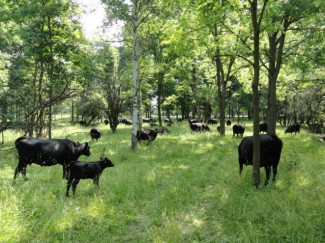by Kate MacFarland, Assistant Agroforester
Many farmers and forest landowners throughout the US are exploring silvopasture, an agroforestry practice that involves raising trees, forage, and livestock on the same piece of land. Some are interested in silvopasture to decrease in the summer by providing shade for their animals. Others are interested in combining the long-term income opportunities from the trees with shorter term income from livestock production. Others are interested in the environmental benefits of trees and wish to keep them on their property while still producing animals. Still others are interesting in using silvopasture to reduce wildfire risks through fuel load reduction.
While woodland or forest grazing is common in many parts of the US, silvopasture is very different from both woodland grazing or simply allowing livestock to have open access to the woods. Silvopasture systems are managed for forage, livestock, and tree production all at the same time. Rotational grazing is an important part of silvopasture management. In addition, in silvopasture systems special care is taken not to degrade the trees. This includes moving livestock frequently, but also protecting young trees and making sure adequate forage is available for the livestock.
Typical silvopasture management practices may include (but are not limited to) soil amendment applications (usually fertilizer and lime) for the forage, pasture renovations, rotational grazing management based on total forage production, chemical and mechanical weed management, tree pruning, hay harvest (in lieu of grazing livestock when trees are young), tree protection, and forest thinning for managing light that reaches the forage. As with all grazing systems, fencing and watering systems are important components of your silvopasture system.
Silvopastures can be created by either planting trees into pastures or thinning stands of trees and planting forages. In either case, silvopasture managers coordinate tree thinning and pruning practices to modify the canopy density in ways that complement sustained forage production throughout the majority of the rotation and meet the needs of canopy species. Tree species are selected that have an economic potential and meet forage light requirements. Forages are selected that thrive in the range of available sunlight that is anticipated with the anticipated canopy management. The forest management, pasture management, and grazing management is conducted in harmony, enhancing the production of multiple, harvestable components.
Producers use a wide array of both tree and livestock species in their silvopasture systems depending their
objectives and on site conditions. Many producers grow their trees primarily for timber and other wood products, while some choose tree and shrub species for different objectives. In the southeast, some producers raise livestock,grow pine for timber, and also harvest pine straw. Some producers grow trees that produce fruit or nuts for harvest, while haying or grazing between the trees. Still others design silvopasture systems to enhance wildlife habitat, including for pollinators, while maintaining an income source from their livestock. Silvopasture systems can be designed for cattle, goats, sheep, poultry, or other livestock species, or they can be designed for multi-species grazing. With careful management of livestock, trees, and forage as your aim, a wide range of systems can be designed to fit your objectives. From Virginia to Minnesota to California and beyond.
The USDA National Agroforestry Center (NAC) offers resources for planning and design of silvopasture systems, as well as resources for training sessions such as sample agendas, presentations, and videos. Visit NAC’s silvopasture page to view or order these and other publications. Sign up to receive email updates or for print publications on NAC’s website.



